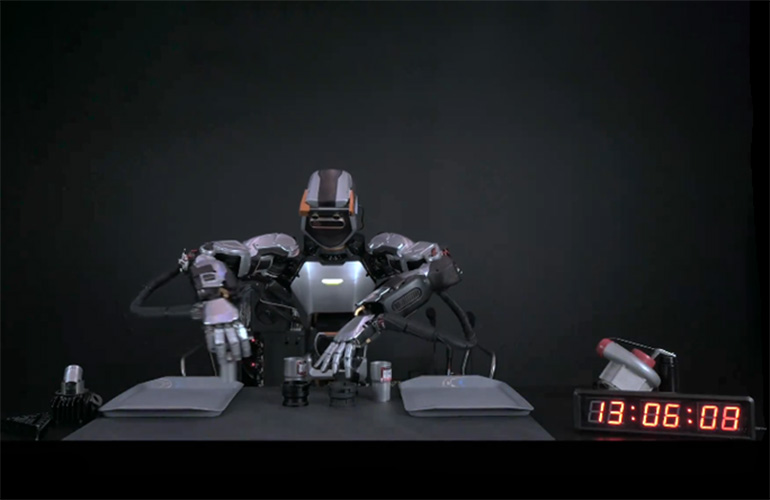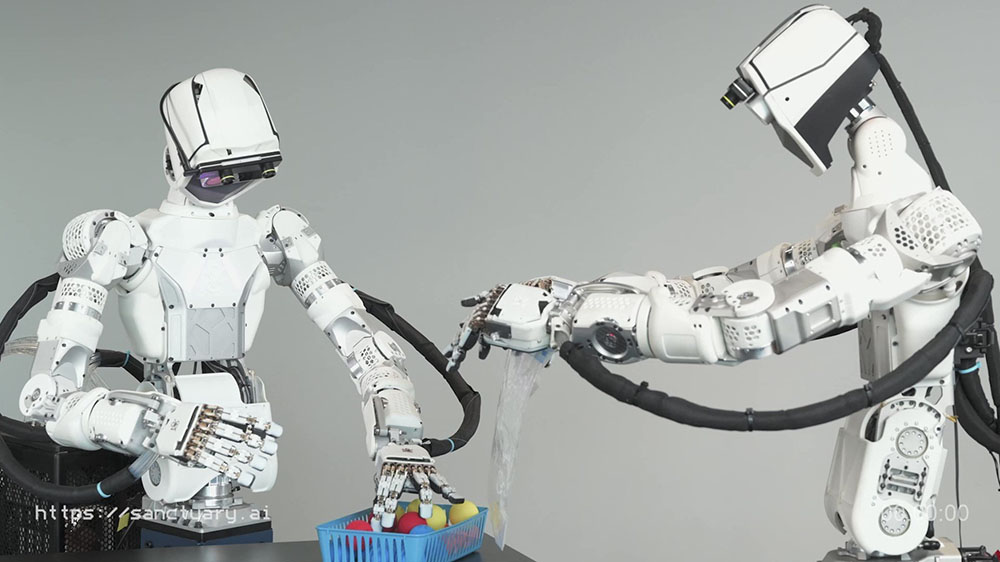|
Listen to this article |

The Phoenix humanoid robot is being developed to enable embodied AI and support general-purpose applications. | Credit: Sanctuary AI
Humanoid robot developer Sanctuary Cognitive Systems Corp., or Sanctuary AI, is entering a new strategic partnership with automotive components supplier Magna International Inc. Through this expanded partnership, Sanctuary plans to equip Magna’s manufacturing facilities with general-purpose AI robots.
The Vancouver-based company also plans to engage Magna to manufacture the Sanctuary Phoenix robots under contract in the future. Aurora, Ontario-based Magna has been an investor in Sanctuary AI since 2021, and it acquired autonomous vehicle startup Optimus Ride in 2022.
Yesterday’s announcement with Magna follows Accenture’s recent investment in Sanctuary for an undisclosed amount.
Phoenix includes human-like design, AI
“We founded Sanctuary AI with the goal to become the first organization in the world to create human-like AI,” stated Geordie Rose, co-founder and CEO of Sanctuary AI. “World-changing goals like these require world-changing partners.”
“Magna’s position as a world leader in the use of robots today makes this partnership an essential advancement for our mission,” he added. “We’re privileged to be working with Magna, and believe they will be a key element in the successful global deployment of our machines.”
Sanctuary Phoenix includes human-like dexterous hands and arms. Since it launched the robot in May 2023, the company has invested heavily in the development of manipulation capabilities, perception features, and artificial intelligence models that control the humanoid robot.
In December 2023, Sanctuary secured patents for numerous technologies developed both internally and through strategic acquisitions from external sources. The company acquired the latest assets from Giant.AI Inc. and Tangible Research.

Sanctuary is iterating on humanoid design by perfecting hand-eye coordination and AI model training. | Credit: Sanctuary AI
Sanctuary AI builds relationship with Magna
“The intent of the relationship [with Magna International] has always been threefold,” Rose told The Robot Report. “One is that they were an investor.”
“Another would be they would participate in manufacturing the robots at some point,” he said. “And the third would be there could be a consumer of the robots as a customer. So all of those three things are obviously related to each other. All of them are good for both parties.”
“So we’ve continued to impress [Magna] with our velocity and acceleration in terms of developing the technology from something that was a twinkle in our eyes six years ago to something that can actually perform real-world work tasks,” Rose noted.
The workflow opportunities for an agile humanoid at Magna are endless, according to Rose. “The key to getting a good fit in the short term is understanding how to overlap that type of analysis with the type of capability that you can deliver,” he said. “So this is a difficult thing for companies that are early stage, including us, because of the ‘drinking your own Kool-Aid’ phenomenon.”
“A lot of companies will release a whole bunch of hype both to their customers, their investors, and internally in themselves — they start to believe that they can do things they can’t, and they make bad decisions about how they position their technology,” Rose continued. “So we have to be clear-eyed about what’s actually possible with our [robot] and then be very diligent in trying to understand the details of how the workflow actually works in practice, and then overlap the two.”
“When you do that with this type of technology, what you find is that the first use cases all fall into the following categories: There is an aspect of mobility, that’s best treated with wheels, where the robot has to move from place to place within an environment. And then there’s the aspect of manipulation,” he explained.
Magna also said its team is excited about the possibilities for intelligent mobile manipulation. It said it expects to automate various tasks and to improve the quality and efficiency of its manufacturing and logistics processes.
“Magna is excited to partner with Sanctuary AI in our shared mission to advance the future of manufacturing,” said Todd Deaville, vice president of advanced manufacturing innovation at Magna. “By integrating general-purpose AI robots into our manufacturing facilities for specific tasks, we can enhance our capabilities to deliver high-quality products to our customers.”
 Learn from Agility Robotics, Amazon, Disney, Teradyne and many more.
Learn from Agility Robotics, Amazon, Disney, Teradyne and many more.
A key success factor for robotics startups
As Sanctuary AI begins the process of commercializing Phoenix, it plans to contract with Magna for the production of part or all of the robot going forward. Sanctuary asserted that finding the right manufacturing partner to build its robots at high volumes is best outsourced and that manufacturing should be non-core for any robotics startup.
Many robotics startups often fail when they attempt to manufacture their systems in-house, observed Rose. He said he has sought to find the right production partner since the inception of the company.
Sanctuary employs embodied AI and foundation models
Embodied AI is core to the future of Sanctuary AI, which said it is spending all of its intellectual energy on engineering and training the smartest models for these robots. Rose said he is amazed at the evolution of embodied AI over the past decade.
The real race, according to Rose, is to find a way to gather the immense amount of data needed and put the robot into the necessary training situations for the AI models to learn and grow in confidence.
This is where the enhanced relationship with Magna comes in. The product roadmap for the Sanctuary over the next year is to deploy all of the production runs of Phoenix robots into real-world manufacturing environments at Magna facilities. In simple terms, Phoenix will learn by executing tasks every day and gathering training data.
“In the run that we’re about to begin with Magna, we’ll be able to collect data in a commercial environment of the sort that will train a production robot,” Rose said. “So the progression of this, from our perspective, is the ability to collect training data to generate autonomous behaviors. The systems that we’re building this year are going to be consumed in data collection.”
In 2025, Sanctuary said it will iterate on a version of the robot for broader use and sale. Similar to the model used at Rose’s prior company, Kindred, there will be a human in the loop to help robots resolve edge cases while minimizing any impact on day-to-day operations.
Rose summed up the current state of development: “We can go from data collection to a trained policy in less than 24 hours now, where the train policy does as well or better than the people who are doing the task for simple tasks. So that is an amazing thing that I was not expecting — these new transformer-based models are spectacularly good at moving robots, way better than I thought they would be.”
“I think it’s an echo of my surprise that how well large language models can generate text; who would have thought that predicting the next token would allow you to be a coherent understander of the world?” he said. “But it seems like that’s the way they work. And in the space of moving robots, if you’ve got enough data, what can’t you do? You can just talk to the robot and say, ‘Do this thing,’ and it will just do it. It’s magical.”





